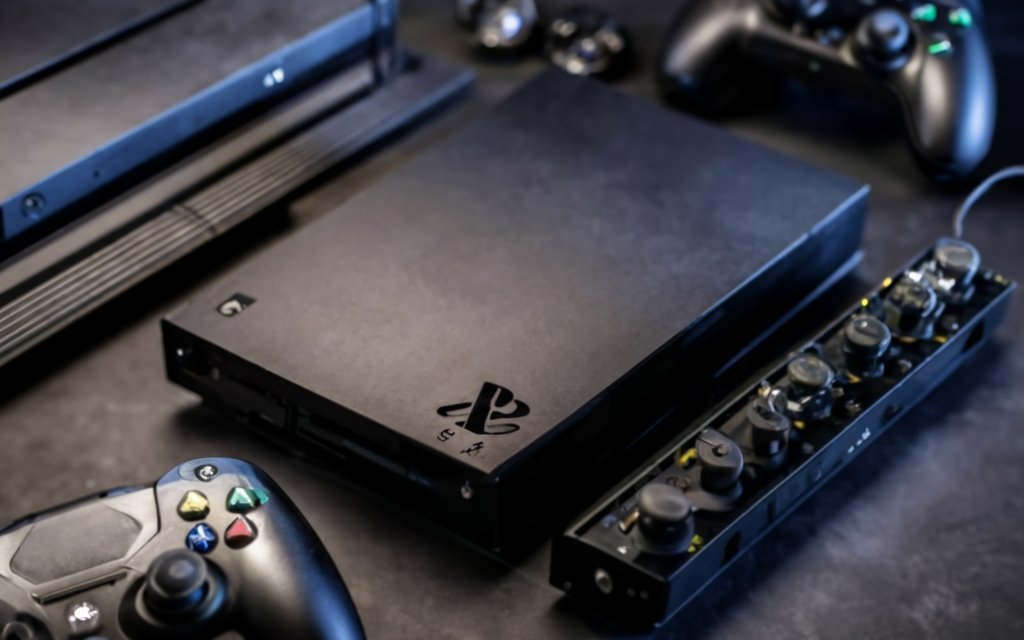Gaming consoles are a complex mix of materials, with the main ones being:
Plastics: This is the most abundant material, used for the outer casing, controllers, internal supports, and various buttons. Common types include ABS (Acrylonitrile butadiene styrene) and polycarbonate, chosen for their durability and affordability.
Metals: Various metals play crucial roles:
- Aluminum: Used for the heat sink to dissipate heat from the processor and graphics chip.
- Copper: Found in circuit boards and wiring for its excellent conductivity.
- Iron: Used for internal structures and some components.
- Precious metals: Gold, platinum, and silver are found in trace amounts on circuit boards for their conductivity and resistance to corrosion.
Glass: Used for the display screens, often with protective coatings like anti-glare or oleophobic (fingerprint-resistant).
Printed circuit boards (PCBs): These are the brains of the console, containing complex circuitry made from various materials:
- Epoxy resin: The base material, providing a strong and insulating platform for electronic components.
- Copper: Used for the conductive traces on the board, carrying electrical signals.
- Solder: Binds components to the PCB and conducts electricity.
- Silicon: Found in integrated circuits (ICs) like CPUs and GPUs, responsible for processing and graphics.
- Other metals: Gold, silver, and palladium are used for plating specific components on the PCB.
Additional materials:
- Rubber: Used for controller grips and buttons for comfort and grip.
- Textiles: May be used for controller straps or internal insulation.
- Rare earth elements: Some components like magnets in motors might contain rare earth elements like lanthanum and neodymium.
The specific materials and their proportions can vary depending on the console model and manufacturer. Environmental concerns are driving efforts to use more recycled materials and improve recyclability at the end of the console’s life.
Inside the Box – A Deep Dive into Gaming Console Materials.
I. Hooked on Hardware: A Glimpse into Gaming Console Guts.
Gaming consoles, portals to thrilling virtual worlds, are more than just sleek plastic boxes. They’re intricately crafted feats of engineering, woven from a diverse tapestry of materials. Let’s peel back the layers and explore what makes these digital playgrounds tick!

II. The Plastic Powerhouse:
Plastic reigns supreme in the console kingdom, providing the foundation for:
- The Mighty Casing: ABS and polycarbonate plastics, chosen for their durability and affordability, form the console’s sturdy shell.
- Grippy Controllers: Plastic buttons and grips offer comfort and control during intense gaming sessions.
- Internal Brawn: Plastic supports and connectors keep the inner workings securely in place.
Table 1: The Plastic Pantheon
| Plastic | Role | Properties |
|---|---|---|
| ABS | Casing, buttons | Durable, affordable, lightweight |
| Polycarbonate | Controllers, internal supports | Strong, impact-resistant, good heat resistance |
But plastic isn’t the only player in this game. Let’s dive deeper into the metallic marvels that make consoles hum:
III. Metal Mayhem: Conductors of Power and Cool.
Metals are the unsung heroes of the console world, playing crucial roles in:
- Heat Dissipation: Aluminum heatsinks draw away scorching temperatures from the processor and graphics chip, ensuring smooth operation.
- Electrical Highways: Copper, a champion of conductivity, weaves through circuit boards, carrying the electrical signals that power the games.
- Structural Support: Iron adds strength and stability to the internal framework.
Table 2: The Metal Menagerie
| Metal | Role | Properties |
|---|---|---|
| Aluminum | Heatsinks | Excellent thermal conductor, lightweight |
| Copper | Circuit boards | Highly conductive, malleable |
| Iron | Internal structures | Strong, abundant, affordable |
Beyond these core materials, fascinating elements like glass (display screens), rubber (controller grips), and even rare earth elements (motors) contribute to the magic behind your gaming experience. Stay tuned for Part 2, where we’ll delve into the intricate world of Printed Circuit Boards and the environmental impact of these technological marvels!
Remember, this is just the beginning of our journey into the fascinating world of gaming console materials. Stay tuned for Part 2, where we’ll unlock the secrets of the brain behind the brawn: the Printed Circuit Board!
Beyond the Plastic and Metal: A Peek at Unseen Heroes.
III. More than Meets the Eye: A Smorgasbord of Specialized Materials.
While plastics and metals form the core, gaming consoles boast a diverse cast of other materials, each playing a crucial role:
- Rubber: Grips on controllers, providing comfort and secure handling during intense battles.
- Textiles: Internal insulation, dampening vibrations and noise.
- Rare Earth Elements: Magnets in motors for rumble features and haptic feedback, adding a layer of immersive realism.
Table 3: Unsung Heroes of the Console Cosmos
| Material | Role | Benefits |
|---|---|---|
| Rubber | Controller grips | Enhanced comfort, secure grip |
| Textiles | Internal insulation | Reduced noise and vibration |
| Rare Earth Elements (Lanthanum, Neodymium) | Motors for rumble and haptic feedback | Realistic in-game sensations |
IV. Green Gaming: Stepping Up for the Planet.
The growing popularity of consoles raises concerns about e-waste and environmental impact. Thankfully, the industry is taking steps towards a greener future:
- Recycled Materials: Increasing use of recycled plastics and metals reduces reliance on virgin resources.
- Improved Recyclability: Designing consoles with easier disassembly and material separation facilitates recycling.
- Energy Efficiency: Focus on optimizing hardware and software for lower power consumption, reducing energy footprint.
Table 4: Green Gaming Initiatives
| Initiative | Impact |
|---|---|
| Increased use of recycled materials | Reduced environmental impact, resource conservation |
| Improved recyclability | Easier disassembly, efficient material separation |
| Energy-efficient hardware and software | Lower power consumption, reduced carbon footprint |
V. Conclusion: A Celebration of Material Marvels.
Gaming consoles, once perceived as simple plastic boxes, are in fact intricate tapestries of diverse materials, each contributing to the magic of virtual worlds. As we strive for a greener future, the industry’s commitment to sustainable practices offers a ray of hope. So, the next time you power up your console, remember the remarkable materials that make it possible – and join the movement towards responsible gaming and e-waste management.
Remember, this journey into the world of gaming console materials is just beginning! By understanding the diverse elements that make these machines tick, we can appreciate their complexity and contribute to a more sustainable future for gaming.
V. The Brain Behind the Brawn: Unveiling the Printed Circuit Board.
Printed Circuit Boards (PCBs) are the unsung heroes of the console world, acting as the intricate nervous system that orchestrates every action, calculation, and visual spectacle. Let’s crack open the casing and explore the fascinating world within:

- Epoxy Resin: The sturdy foundation, providing insulation and support for the delicate circuitry.
- Copper Traces: The information highways, etched onto the board, carrying electrical signals like data packets rushing through a digital metropolis.
- Solder: The microscopic glue, binding components to the board and ensuring smooth signal flow.
- Silicon Chips: The masterminds of the operation, housing the integrated circuits (ICs) like the CPU and GPU that process information and render graphics. These chips are made of silicon, the same element found in sand, transformed into miniature marvels of computing power.
Table 5: PCB Powerhouses
| Component | Role | Properties |
|---|---|---|
| Epoxy Resin | Foundation | Strong, insulating, heat-resistant |
| Copper Traces | Conductors | Excellent electrical conductivity, malleable |
| Solder | Bonding agent | Conducts electricity, melts at low temperatures for secure connections |
| Silicon Chips | Processing powerhouses | House ICs like CPU and GPU, contain billions of transistors |
VI. A Symphony of Circuits: Understanding PCB Function.
The PCB is a masterpiece of miniaturization, housing a complex orchestra of components that work in tandem:
- The Conductor: The CPU: Reads and interprets instructions, directing the flow of information throughout the system.
- The Graphics Maestro: The GPU: Transforms data into stunning visuals, painting the digital canvas of your gaming world.
- The Memory Chorus: RAM (Random Access Memory) stores temporary data for quick access, while ROM (Read-Only Memory) houses permanent instructions.
- The I/O Band: Input/Output ports connect your console to controllers, storage devices, and displays.
This intricate dance of components orchestrated by the PCB is what brings your favorite games to life!
Remember, the PCB is the hidden gem of the gaming console, a testament to human ingenuity in miniaturization and collaboration. By understanding its complex symphony of circuits, we gain a deeper appreciation for the technological marvel that powers our virtual adventures.
Stay tuned for future explorations into the ever-evolving world of gaming console technology! The journey has just begun!
VII. Beyond the Core: A Peek at Additional Materials.
While the materials covered so far form the backbone of most gaming consoles, there are some additional components worth mentioning:
- Glass: The pristine canvas for your virtual worlds, displaying stunning visuals in LCD or OLED panels. Some consoles utilize specialized coatings like anti-glare or oleophobic for enhanced viewing experiences.
- Rare Earth Elements: These critical components find their way into motors used for haptic feedback and rumble features, adding a layer of immersive realism to your gameplay. Lanthanum and neodymium are commonly found in these motors.
- Liquid Metal: Some high-performance consoles employ liquid metal thermal compounds to efficiently dissipate heat from the processor and graphics chip, ensuring optimal performance and stability.
Table 6: Beyond the Basics
| Material | Role | Benefits |
|---|---|---|
| Glass | Display panels | High-resolution visuals, anti-glare/oleophobic options |
| Rare Earth Elements (Lanthanum, Neodymium) | Haptic feedback, rumble motors | Immersive in-game sensations |
| Liquid Metal (Thermal Compound) | Heat dissipation | Enhanced performance, improved stability |
VIII. A Look to the Future: Innovation in Materials
The world of gaming console materials is constantly evolving, with exciting advancements on the horizon:
- Biodegradable Plastics: Research into using plant-based or biodegradable plastics for console casings and components is gaining traction, aiming to reduce e-waste and environmental impact.
- Self-Repairing Materials: Imagine a future where console components can detect and repair minor damage, extending the life of your gaming device and reducing waste.
- Nanomaterials: These tiny marvels hold the potential for even smaller and more efficient circuits, leading to even more powerful and immersive gaming experiences.
Table 7: The Future of Console Materials
| Material | Potential benefits |
|---|---|
| Biodegradable Plastics | Reduced e-waste, environmentally friendly |
| Self-Repairing Materials | Extended lifespan, reduced waste |
| Nanomaterials | Smaller, more efficient circuits, enhanced performance |
Remember, the future of gaming console materials is bright, driven by a commitment to sustainability, innovation, and pushing the boundaries of what’s possible. Stay tuned to see what exciting materials and technologies will shape the next generation of gaming experiences!

This concludes our exploration of the materials that make up your favorite gaming console. From the plastic powerhouse to the intricate symphony of the PCB, we’ve delved into the fascinating world behind the virtual worlds you love. Keep exploring, keep playing, and keep curious about the materials that make it all possible! You should read another article i wrote about >>>> What Makes Up a Video Game Console? to learn more.






